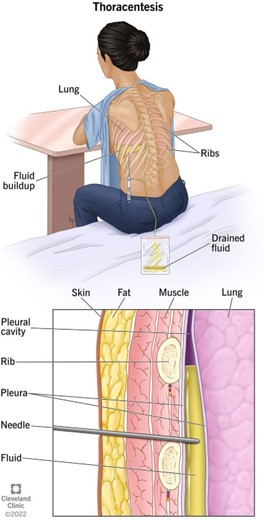A nurse is reinforcing teaching with a client who is about to undergo a thoracentesis. Which of the
following statements by the client indicates an understanding of the information?
I will have general anesthesia during the procedure.
I will lie flat for 6 hours following the procedure.
I will have a chest x-ray following the procedure
I will breathe deeply through my nose during the procedure
The Correct Answer is C
c. "I will have a chest x-ray following the procedure."
Explanation:
The statement that indicates an understanding of the information provided is "I will have a chest x-ray following the procedure."
Explanation for the other options:
a. "I will have general anesthesia during the procedure":
This statement is incorrect. Thoracentesis is typically performed using local anesthesia, which numbs the area where the needle will be inserted. General anesthesia, which induces a state of unconsciousness, is not usually required for this procedure.
b. "I will lie flat for 6 hours following the procedure":
This statement is incorrect. While the client may be advised to lie still for a short period after the thoracentesis, it is not necessary for them to lie flat for a full 6 hours. The specific post-procedure instructions may vary depending on the client's condition and the healthcare provider's preferences.
d. "I will breathe deeply through my nose during the procedure":
This statement is incorrect. During a thoracentesis, the client is typically asked to sit upright and lean forward to allow beter access to the space between the lungs and chest wall. They may be instructed to take slow, deep breaths and hold their breath for short periods as needed during the procedure to help maintain proper positioning and reduce the risk of complications.
In summary, the statement that demonstrates an understanding of the thoracentesis procedure is "I will have a chest x-ray following the procedure." This indicates the client's awareness of the need for a post- procedure chest x-ray to evaluate the results and ensure the absence of any complications.

Nursing Test Bank
Naxlex Comprehensive Predictor Exams
Related Questions
Correct Answer is ["A","B","D","F"]
Explanation
Answer: A, B, D, F
Rationale:
A. "The ECT procedure will cause you to have a brief seizure.":
This statement is accurate as electroconvulsive therapy (ECT) intentionally induces a controlled seizure, which is thought to positively impact brain chemistry and alleviate symptoms of major depressive disorder. Educating the client about this aspect helps demystify the procedure and reduces anxiety.
B. "You will not be awake during the ECT procedure.":
The client receives general anesthesia before ECT, so they will be unconscious during the procedure. This reassurance can help alleviate fears associated with being awake and experiencing discomfort during the procedure.
C. "You will be placed on a ventilator to help you breathe during the ECT procedure.":
During ECT, clients do not require a ventilator, although they may receive oxygen support. An anesthetic and muscle relaxant are administered, and while the client’s breathing is closely monitored, a ventilator is unnecessary for this brief procedure.
D. "You will probably sleep the rest of the day following the ECT procedure.":
Many clients feel drowsy and need extra rest after ECT due to the effects of anesthesia and the brief seizure. Informing the client helps them prepare for this common effect and sets realistic expectations for their recovery period.
E. "It should only take one ECT treatment to bring you out of your depression.":
ECT is typically given as a series of treatments over several weeks to achieve lasting improvement in depressive symptoms. One treatment alone is usually insufficient, so this statement could mislead the client regarding the treatment plan.
F. "Some clients experience temporary memory loss following ECT therapy.":
Temporary memory loss, especially of recent events, is a known side effect of ECT. This side effect is generally transient but can help the client to be aware of this possibility, helping them to anticipate and manage any concerns post-treatment.
Correct Answer is B
Explanation
Explanation:
The nurse should respond by recommending that the parent avoids administering aspirin to the child. The use of aspirin in children, especially those under the age of 18, is associated with the risk of developing Reye's syndrome, a rare but serious condition that affects the liver and brain. It is important to educate parents about the potential risks of using aspirin in children, particularly when they have a fever. Instead, the nurse should advise the parent to use appropriate dosages of acetaminophen or ibuprofen based on the child's weight and follow the label directions for administration.
Option a suggests following the label directions based on the child's weight, which may not specifically address the use of aspirin in children and the risk of Reye's syndrome. Option c, stating that the child will require an antibiotic if she develops a fever, is incorrect because antibiotics are not indicated for all fevers and should only be prescribed if there is an underlying bacterial infection. Option d, suggesting that the child can have two baby aspirins every 4 hours, is incorrect and contradicts the recommendation to avoid administering aspirin to the child.
Whether you are a student looking to ace your exams or a practicing nurse seeking to enhance your expertise , our nursing education contents will empower you with the confidence and competence to make a difference in the lives of patients and become a respected leader in the healthcare field.
Visit Naxlex, invest in your future and unlock endless possibilities with our unparalleled nursing education contents today
Report Wrong Answer on the Current Question
Do you disagree with the answer? If yes, what is your expected answer? Explain.
Kindly be descriptive with the issue you are facing.
